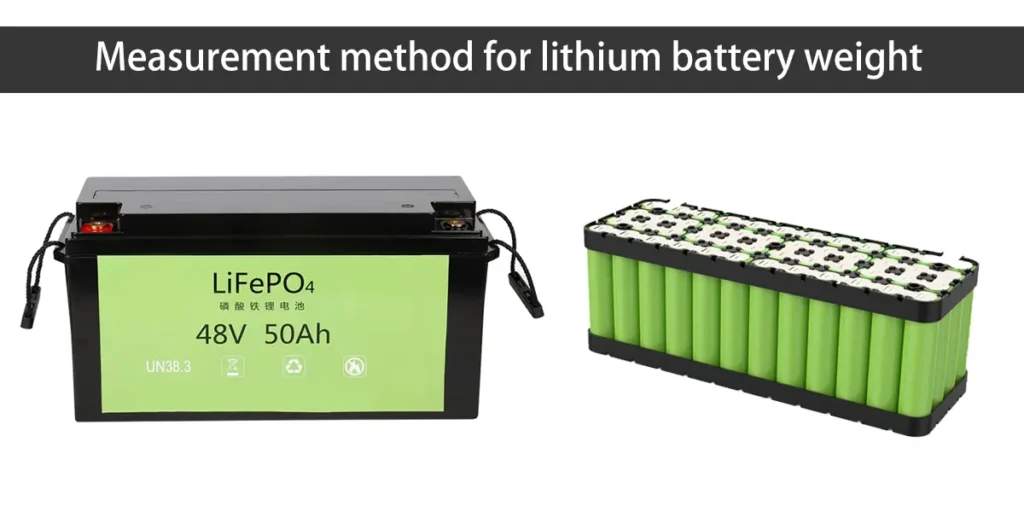Want to know how much a lithium battery weighs? This article will explain in detail how to calculate the weight of lithium batteries, the factors that affect it, and the application considerations. You will learn about the weight range of different types of lithium batteries, as well as the key factors that affect weight. Whether you are an engineer, a student, or a hobbyist interested in lithium batteries, this article can help you quickly master the knowledge of lithium battery weight. The weight of lithium batteries directly affects the range of electric vehicles and the ease of use of portable devices, so it is crucial to master their weight information.
Last updated: May 17, 2025 | Estimated reading time: 8 minutes
Table of Contents
ToggleHow to calculate the weight of lithium battery

The weight of a lithium-ion battery depends on its size, chemistry, and energy storage capacity. A typical battery cell weighs about 30-40 grams. Battery cells are packaged together to form a device’s battery pack. Batteries for computers, cell phones, and other portable electronic devices typically contain multiple battery cells connected in series (positive to negative) or in parallel (positive to positive).
The Li-ion Battery Weight Calculator is a lightweight, easy-to-use tool that helps you estimate the approximate weight of a Li-ion battery based on its specific energy, density, and volume. To use the calculator, you need to enter the milliamp-hours (mAh) and volts (V) of each battery, which you can obtain from us.
The first step in calculating the weight of a lithium-ion battery pack is to determine its capacity in ampere-hours (Ah). This capacity is usually included in the product specifications for off-the-shelf batteries; in the case of a custom battery pack, it is calculated by dividing the total energy (in watt-hours) by the nominal voltage.
Next, we need to understand the specific energy of the battery chemistry. The following table provides approximate values for common formulations:
| Lithium Ion Chemistry | Specific Energy (Wh/kg) |
|---|---|
| Lithium Cobalt Oxide (LCO) | 140 – 175 |
| Lithium Manganese Oxide (LMO) | 115 – 145 |
| Lithium Iron Phosphate (LFP) | 95 – 120 |
| Lithium Nickel Manganese Cobalt Oxide (NMC) | 115 – 150 |
If you are using an off-the-shelf battery, your manufacturer may have published specific energy information. Otherwise, we can estimate a value based on our chemistry. For example, a lithium manganese oxide battery with a nominal voltage of 3.6V and a specific energy of 120 Wh/kg has a capacity of 33 Ah and weighs 1kg.
Factors affecting the weight of lithium batteries
The weight of a lithium-ion battery pack is not a fixed number; it depends on the storage capacity and voltage of the pack. The most promising way to increase the energy density of a battery is to increase the voltage, but this also comes with some drawbacks. The voltage can be increased by adding more cells, making for a smaller, lighter battery. More cells means more weight.
- Battery type and chemistry. The cathode material accounts for about 30% of the mass of a lithium-ion battery cell. The anode also accounts for about 30%. The separator accounts for 15%, and the current collector is slightly less than 10%. The electrolyte (including additives) accounts for about 2%, and the remaining components account for about 13%.
- Battery capacity and voltage. A typical laptop battery contains six cells rated at 3.6V.
For example, the Dell Inspiron 9100 laptop has a battery rated at 11.1V and a capacity of approximately 4400 mAh (4.4 Ah). This equates to 6 x 3.6V x 4.4Ah = 100 Whr of energy or 1110 g of mass (2.5 lbs). - Components of a battery. Lithium-ion batteries are made up of several different parts: cathode, anode, separator, electrolyte, and current collector. The chemistry of the cathode and anode determines the type of lithium-ion battery (e.g., LiCoO2, LiFePO4, etc.), which in turn determines the battery’s capacity, rate capability, safety features, and cost. Typical battery configurations in vehicles are either prismatic or cylindrical, with capacities between 20-85 Ah.
Application considerations of lithium battery weight
Battery weight affects a variety of applications, including:
- Laptops. A typical laptop battery weighs between 80 and 120 Wh/kg, which means it weighs between 240 and 960 grams (or 0.5 to 2 pounds).
- Smartphones. A typical smartphone battery might weigh around 20 to 40 grams.
- Electric vehicles. An electric car that needs 100 kWh of energy, which can be stored at 95% efficiency in 18650 lithium-ion cells alone, would require 14,285 cells. Each cell weighs about 50 grams, for a total weight of 714 kg (1,574 lb).
Lithium battery lightweight technology

Lithium-ion battery gravimetric density: Lithium-ion batteries have a much higher power density than their predecessors. But they also have a higher specific energy – typically 150 Wh/kg, compared to 50 Wh/kg for lead-acid batteries and 70-90 Wh/kg for NiMH batteries.
The weight breakdown for the lithium-ion battery pack is as follows:
- Battery cell – 48%
- Packaging – 25%
- Others (cables, connectors, contactors, etc.) – 9%
- Cooling system – 5%
- Battery management system – 5%
- Hardware / supporting structure – 4%
- Security systems – 2%
- Miscellaneous (fans, electrical components) – 2%
Conclusion
The weight of lithium-ion batteries can be as low as 3 grams per watt-hour and as high as 8 grams per watt-hour. When choosing a lithium battery, you need to consider factors such as weight, energy density, safety, and cost to meet the needs of different application scenarios. If you are still worried about the overweight of lithium batteries, please contact us Hongyitai to get the best battery solution.
